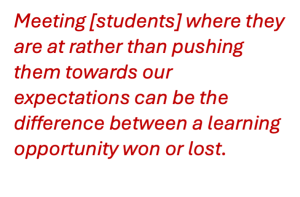We sometimes forget that learners are at different points along the learning continuum. Our students range from beginning to advanced, and all points in between. While we pitch our lessons to the middle, and expect our students to meet the objectives, the students at the lower end of the continuum tend to get left behind. Yet, these learners present us with the greatest opportunity for teaching and learning in the use of differentiated instruction.
Profile of a Literacy Learner
Senet (not her real name) is one such student in my literacy class. She is semi-literate, and shows strategic and perceptual gaps, little ability to connect sound to symbols, little ability to decode word parts, few strategies for learning, and low levels of confidence. On the flip side, she demonstrates being able to discriminate between same and different, has demonstrated emerging visual/perceptual skills, can copy with some accuracy, and she has demonstrated an emerging ability to place text on lines and to put spaces between letters and words.
No Assumptions
I realized at the start of our grocery shopping module that she needed to work on decoding words. She wasn’t yet able to recognize themes, such as how food is organized into different sections of a grocery store. It was also clear that she was not going to learn all the vocabulary — words I had mostly elicited from the learners themselves.
To help Senet, I had to move from being an authority to a facilitator, rethink the timeline I had set for the various tasks, and, most of all, release my assumptions of what the students could and couldn’t do, and what they knew and didn’t know.
With Senet, I had to readjust my expectations and level of support, that is, engage in differentiated instruction. One way I did this was to become a facilitator for her and give her more one on one time than I normally do with the students.
My Methodology with Senet
I’ll give two examples of how I differentiated my instruction with Senet. Overall, I simplified the material and my expectations for her.
First, I had her work on Learning Chocolate programs, rather than the Avenue module that the more advanced students were more or less adept at. One reason I did this is that Senet needs to develop her sound-symbol recognition skills. Learning Chocolate uses phonics for reading and writing, so this program directly addressed Senet’s need to make sound-symbol connections, and to decode words. Also, the Learning Chocolate program I used with her is way simpler for students with emerging digital literacy skills than the Avenue unit. With Learning Chocolate, there were only four words she was learning: produce, meat, dairy, and bakery. Four words wouldn’t cognitively overload her.
Second, I sat with her. I went through all five exercises with her. However, she was the one who moved the cursor, clicked, double-clicked, dragged and dropped. We also worked on navigating to Avenue, signing-in, and navigating to the Learning Chocolate activities I had amended to the food unit. After I modeled what she needed to do, I let her work on her own, drifting by every now and then to see how she was doing.
A Reminder of Best Practice
This moment with Senet was an important lesson for me. It reminded me that our learners progress at their own pace. Meeting them where they are at rather than pushing them towards our expectations can be the difference between a learning opportunity won or lost. I hope Senet is a better student now, developing skills with greater confidence.

